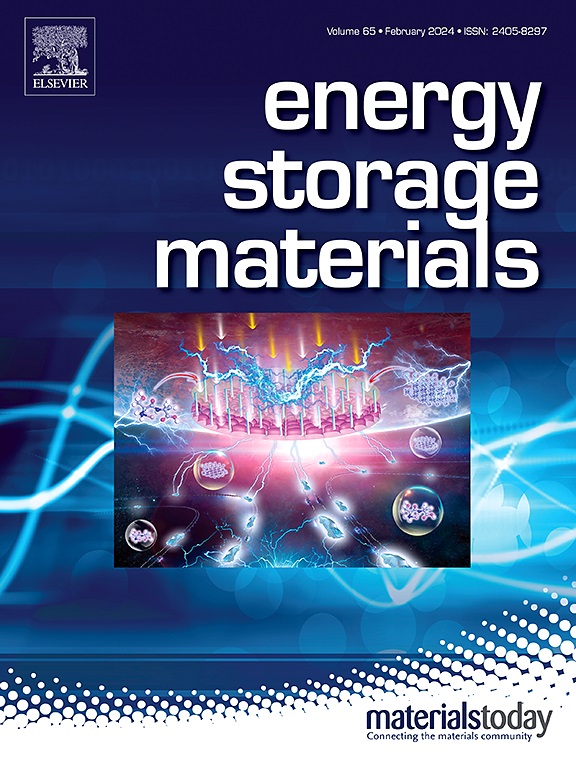纳米材料对锌空气电池性能的优化研究
IF 20.2
1区 材料科学
Q1 CHEMISTRY, PHYSICAL
引用次数: 0
摘要
化石能源的枯竭和日益严重的环境恶化共同推动了新能源的研究和开发,从而促进了新型环保可再生能源设备的出现和利用。锌空气电池作为新型绿色电池系统的典型代表,以其理论比容量高、本质安全、性能稳定等独特优点被认为是一种高效的可充电能源装置。但锌枝晶、腐蚀、钝化、可逆性差、电解液稳定性弱、氧化还原反应动力学慢等因素制约了锌空气电池的规模化推广。纳米材料由于其独特的物理和化学性质,已成为弥补锌空气电池缺点的可行替代材料。纳米材料与锌-空气电池的结合研究在锌电极、电解质和空气电极双功能催化剂等领域取得了丰硕的成果。本文以锌空气电池当前面临的挑战为出发点,结合纳米材料的典型优势,对利用纳米材料优化锌空气电池性能的研究报道进行了深入的综述,突出了纳米材料在提高锌电极可逆性、增强电解质稳定性和提高空气电极双功能催化活性方面的显著优势。在此基础上,为纳米材料与锌空气电池的深度融合和进一步研究奠定了基础,并对未来的发展提出了展望。本文章由计算机程序翻译,如有差异,请以英文原文为准。
Performance optimization of zinc-air batteries via nanomaterials
The depletion of fossil energy and the increasingly serious environmental deterioration have jointly promoted the research and development of new energy sources, and thus facilitated the emergence and utilization of new environmentally friendly renewable energy equipment. Zinc-air battery, as a typical representative of new green battery system, is considered as an efficient rechargeable energy device because of its special advantages such as high theoretical specific capacity, intrinsic safety and stable performance. However, zinc dendrites, corrosion, passivation, poor reversibility, the weak stability of electrolyte, slow redox reaction kinetics and other factors restrict the scale popularization of zinc-air batteries. Benefiting from their unique physical and chemical properties, nanomaterials have become a feasible alternative to make up for the shortcomings of zinc-air batteries. The research on the combination of nanomaterials and zinc-air battery have made substantial achievements in the fields of zinc electrode, electrolyte and air electrode bi-functional catalysts. In this paper, the current challenges of zinc-air batteries are taken as the starting point, combined with the typical advantages of nanomaterials, the research reports on optimizing the performance of zinc-air batteries through nanomaterials are reviewed in depth, highlighting the significant advantages of nanomaterials in improving the reversibility of zinc electrodes, enhancing electrolyte stability and improving the bi-functional catalytic activity of air electrodes. On this basis, it lays a foundation for the deep integration and further research of nanomaterials and zinc-air batteries, and puts forward the prospect for future development.
求助全文
通过发布文献求助,成功后即可免费获取论文全文。
去求助
来源期刊

Energy Storage Materials
Materials Science-General Materials Science
CiteScore
33.00
自引率
5.90%
发文量
652
审稿时长
27 days
期刊介绍:
Energy Storage Materials is a global interdisciplinary journal dedicated to sharing scientific and technological advancements in materials and devices for advanced energy storage and related energy conversion, such as in metal-O2 batteries. The journal features comprehensive research articles, including full papers and short communications, as well as authoritative feature articles and reviews by leading experts in the field.
Energy Storage Materials covers a wide range of topics, including the synthesis, fabrication, structure, properties, performance, and technological applications of energy storage materials. Additionally, the journal explores strategies, policies, and developments in the field of energy storage materials and devices for sustainable energy.
Published papers are selected based on their scientific and technological significance, their ability to provide valuable new knowledge, and their relevance to the international research community.
 求助内容:
求助内容: 应助结果提醒方式:
应助结果提醒方式:


